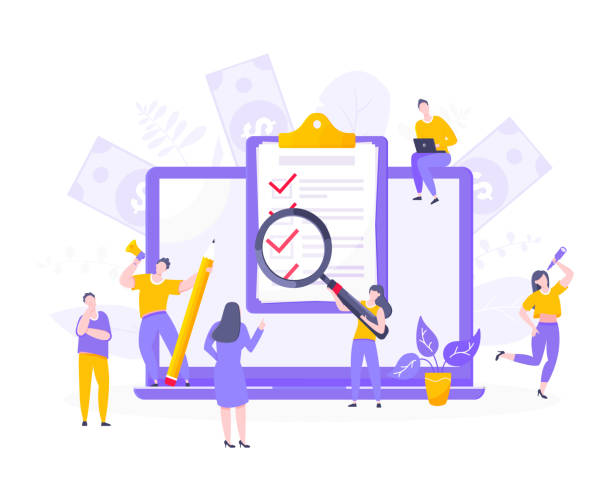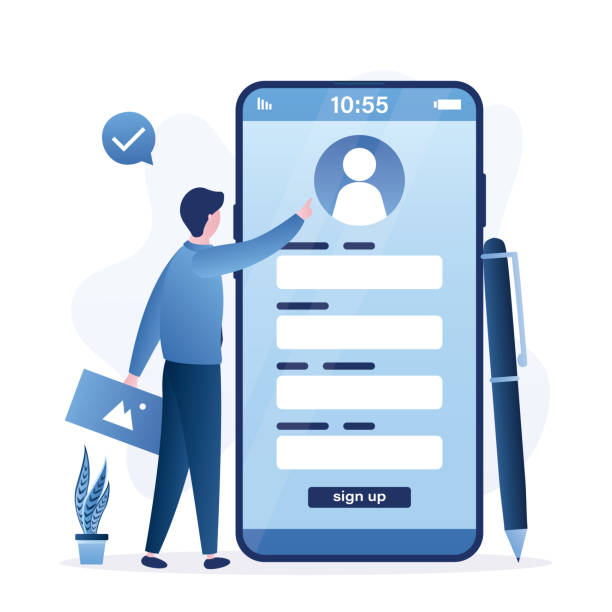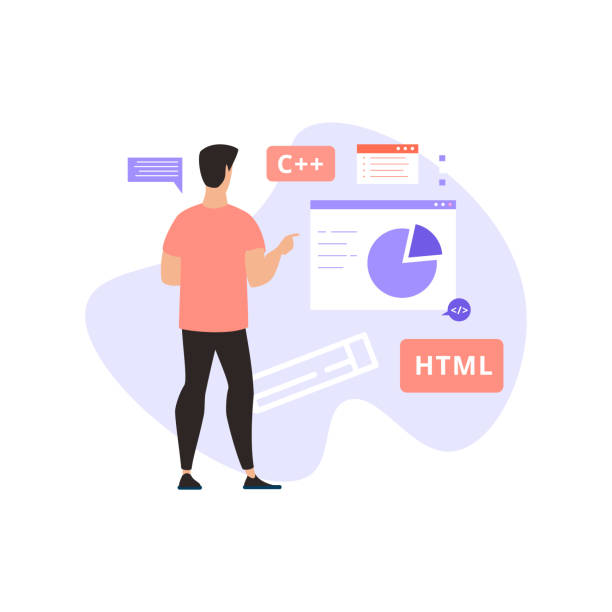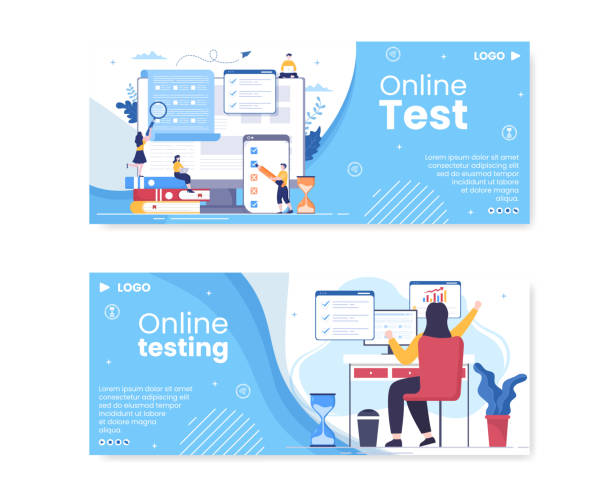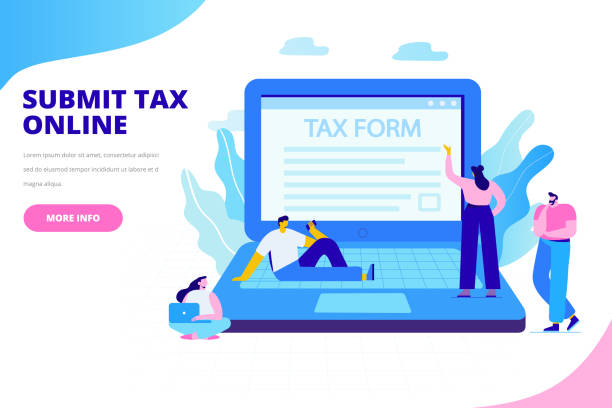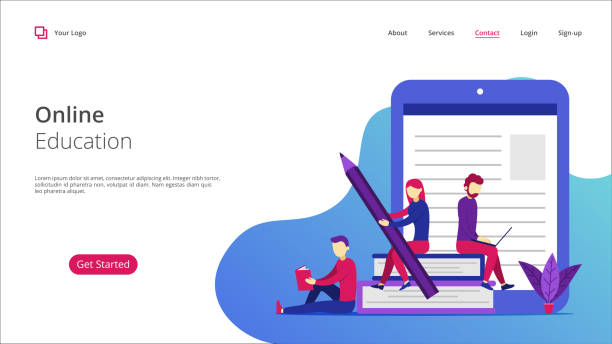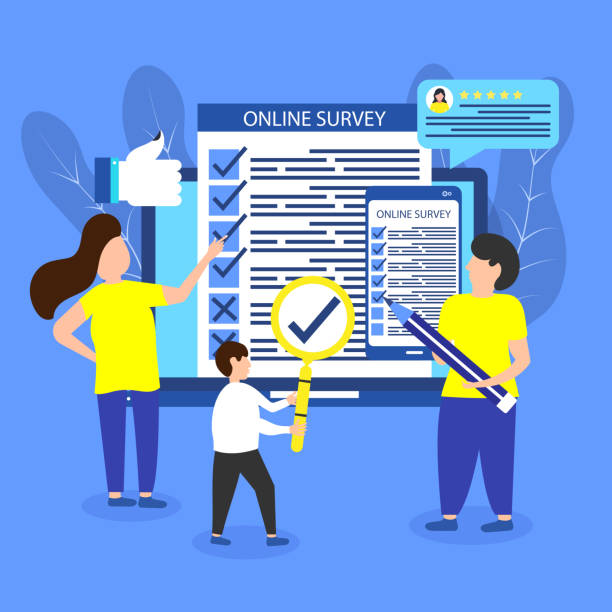1. Why is Designing a Personal Website Essential Today?
In today’s digital world, having a personal website is no longer a luxury, but a necessity.
This online platform allows you to establish your #online_presence, build your #personal_brand, and showcase your skills and experiences.
Whether you are an artist, writer, developer, consultant, or even a job seeker, personal website design allows you to control your narrative without depending on #social_media platforms.
This is your platform, where you set the rules and your content remains forever.
The main goal of personal website design is to create a central hub for all your professional activities and even personal interests.
This website can include portfolios, resumes, blog posts, personal projects, and even a small store.
It is a powerful tool for #networking, attracting new clients or potential employers.
Additionally, having a personal website significantly boosts your credibility and shows that you are a specialist and professional in your field.
It is a digital business card available 24/7, helping you reach your audience anytime, anywhere.
This is the explanatory aspect of the matter that helps you understand the necessity of this work.
Today, with the proliferation of website building tools, personal website design has become much easier than before.
You no longer need to be a programmer to have a professional site.
#Website_builders and content management systems like WordPress have made it possible for anyone with minimal technical knowledge to launch their website.
This process not only reduces costs but also minimizes the time required for launch.
This website can also serve as an #educational tool, where you can share your knowledge or even offer your own courses.
Tired of losing customers due to poor e-commerce website design? With Rasaweb, solve this problem forever!
✅ Increase sales and visitor-to-customer conversion rate
✅ Smooth and engaging user experience for your customers⚡ Get Free Consultation
2. Strategic Planning for Personal Website Design
Before you even write a line of code or choose a theme, the most important step in personal website design is #strategic_planning.
This stage involves defining goals, identifying your audience, and #content_selection.
Questions you should ask yourself include: “What is the main purpose of my website?” (e.g., showcasing portfolios, attracting clients, educating, or selling products), “Who is my audience?” and “What type of content will be appealing to them?”
The answers to these questions will form the basis of all your subsequent decisions.
For example, if your goal is #attracting_employers, your website should include a strong resume, relevant portfolios, and clear contact information.
If you intend to work as a blogger, you should focus on producing valuable and engaging content.
#Thought-provoking_content can help you engage more with your audience, ask them questions, or respond to their comments.
Every part of your website should align with your overall goals.
This stage is a very important guide that prevents you from wasting time and resources.
After setting goals, it’s time to #identify_your_audience.
Are your audiences #industry_professionals or the general public? How much do they know about your topic? This information helps you adjust the tone, style, and even the overall design of your website.
Choosing appropriate keywords at this stage is also crucial for your website to be visible in search results.
Designing a personal website with precise planning will ensure its long-term success and help you create a cohesive and effective platform.
Paying attention to details at this stage, such as sitemapping and #defining_navigation_structure, is vital.
This helps ensure that visitors can easily find the information they need.
The more logical and user-friendly your website’s structure, the better the user experience it will provide, and users will spend more time on your site.
3. Choosing the Right Platform and Tools for Personal Website Design
After the planning stage, it’s time to choose the right platform for personal website design.
You have several options, each with its own advantages and disadvantages.
Among the most popular options are #Content_Management_Systems (CMS) like WordPress, website builder platforms such as #Wix or Squarespace, and coding from scratch.
Choosing a platform that aligns with your needs, budget, and technical skills is of paramount importance.
WordPress, due to its high flexibility, numerous plugins, and large user community, is one of the most popular choices for personal website design.
This platform offers high customizability and is suitable for various types of websites, from blogs to online stores.
However, it requires some technical knowledge for setup and maintenance.
In contrast, website builders like #Wix and #Squarespace are options for those with less technical knowledge who want to build a website quickly and easily.
These platforms provide visual design capabilities with #drag-and-drop interfaces, but generally offer less flexibility than WordPress and may incur higher costs in the long run.
Coding from scratch (HTML, CSS, JavaScript) gives you the ultimate flexibility, but it is suitable for those with advanced programming knowledge.
This method is recommended for highly specific and customized projects.
Choosing the correct specialized platform will directly impact the efficiency and scalability of your website.
To help you decide, refer to the table below:
Click here to preview your posts with PRO themes ››
| Feature | WordPress | Website Builders (Wix, Squarespace) | Coding from Scratch |
|---|---|---|---|
| Ease of Use | Medium (requires learning) | High (beginner-friendly) | Low (requires coding knowledge) |
| Flexibility and Customization | High | Medium | Highest |
| Initial Cost | Medium (hosting and domain) | Higher (monthly/annual subscription) | Variable (hosting, tools) |
| Maintenance and Security | Requires relative knowledge | Less (platform is responsible) | Entirely your responsibility |
4. Principles of Visual Design and User Experience (UX)
Aesthetics and usability are two main pillars in personal website design.
An attractive #visual_design and optimal #user_experience (UX) play a vital role in retaining visitors and encouraging them to interact with your website.
Your website should not only look beautiful but also be easy and enjoyable to use.
This includes choosing the right layout, colors, fonts, images, and white space.
A cluttered and disorganized website can immediately drive visitors away.
A proper user experience means easy navigation, fast loading times, and #responsive_design, meaning your website should display well on all devices, including desktops, tablets, and smartphones.
This is the analytical aspect of design that helps you predict and optimize user behavior.
Additionally, using visual hierarchy helps visitors quickly identify the most important information.
This is done by using different font sizes, colors, and element positions.
A personal website with a user-friendly design can become a powerful tool for #attracting_audiences and #converting_visitors into customers or followers.
This is a key lesson that should be given special attention throughout the design process.
Colors and fonts have a significant impact on your #audience’s_perception of your brand.
Choosing a harmonious color palette and fonts that are highly readable and consistent with your brand’s personality is very important.
Remember that simplicity is usually the best approach.
Avoid unnecessary design complexities to keep the focus on your core content and prevent user experience from being compromised.
These principles form the foundation of #personal_website_design.
Disappointed with your e-commerce site’s low conversion rate? Rasaweb transforms your e-commerce site into a powerful tool for attracting and converting customers!
✅ Significant increase in visitor-to-buyer conversion rate
✅ Unparalleled user experience to boost customer satisfaction and loyalty⚡ Get Free Consultation from Rasaweb!
5. Creating Engaging and Useful Content
Content is king, and this statement fully applies to personal website design.
Without #engaging_and_valuable_content, your website is like an empty storefront.
Content types include text (blog articles, “About Me” and “Contact Us” pages), images (portfolios, personal and professional photos), videos (introductions, tutorials), and audio files (podcasts).
Your content should not only be informative but also #entertain visitors and encourage them to interact.
To create #thought-provoking_content, you can create Q&A sections, surveys, or calls for comments.
This makes visitors feel heard and part of your community.
For personal websites, #storytelling is especially important.
Through your content, tell your personal and professional story in a way that resonates with your audience.
Producing #specialized_content demonstrates your knowledge and expertise in your field.
In-depth articles, analyses, and practical guides can enhance your credibility.
Always remember that your content should be #up-to-date and relevant.
Planning for regular content publication can encourage visitors to return to your site and also helps improve #SEO.
The content you produce should address the needs and questions of your audience.
Before writing, conduct #keyword_research to understand what your audience is looking for.
Use high-quality images and videos to make your content more visual and appealing.
Always adhere to #content_originality and avoid plagiarism.
A personal website with unique and valuable content can differentiate you from competitors.
This part of personal website design plays a vital role in its success.
6. Search Engine Optimization (SEO) for Personal Websites
After designing your personal website and creating content, the next step is to ensure that your website can be found by search engines like Google.
#Search_Engine_Optimization or #SEO is a set of techniques that helps increase your website’s visibility in search results.
A website without SEO is like a library without shelves; no one can find it.
The first step in SEO is #keyword_research.
Identifying the words your audience uses to find services or content similar to yours is crucial.
These words should be naturally incorporated into your titles, texts, meta descriptions, and URLs.
This is a #specialized aspect that requires precision.
SEO is divided into two main parts: #On-Page_SEO and #Off-Page_SEO.
On-page SEO involves optimizing elements within your website, such as content, images, link structure, and page loading speed.
Ensuring your website is #responsive and #mobile-friendly also falls into this category.
Off-page SEO involves activities outside your website, such as #backlink_building (links from other websites to yours) and social media activity.
These activities signal to search engines that your website is credible and popular.
This process is continuous and requires regular monitoring and updates to keep your personal website at the top of search results.
Remember that SEO is a long-term investment whose results appear gradually, but it is vital for the success of your #personal_website_design.
Click here to preview your posts with PRO themes ››
7. Launching and Promoting a Personal Website
After completing the personal website design and optimization stages, it’s time for the exciting launch and promotion phase.
This stage not only means putting your website online but also includes strategies for attracting visitors.
Before launching, prepare a #final_launch_checklist to ensure all links are working, images are displayed correctly, and contact forms are active.
This guidance aspect is very important.
After launching, it’s time to introduce your website to the world.
#Social_media platforms are powerful tools for this purpose.
Publish posts, stories, and live sessions that link to your website.
You can announce the #news of your new website launch on LinkedIn or other professional platforms.
#Email_marketing is another effective method.
If you have an email list, inform them that your website is online and invite them to visit.
Participate in industry events and verbally promote your website.
Collaborating with other bloggers or experts in your field can also help increase your visibility.
This news and promotional section is very important.
Finally, don’t forget that #website_performance_monitoring after launch is also crucial.
Use tools like #Google_Analytics to track traffic, user behavior, and traffic sources.
This information helps you improve your strategies and continuously optimize your personal website.
Personal website design is only half the battle; effective promotion is the other half.
| Promotion Method | Description | Advantages | Potential Disadvantages |
|---|---|---|---|
| Social Networks | Sharing content and links on platforms like Instagram, LinkedIn, Twitter. | Quick access to a wide audience, high engagement. | Requires continuous presence, changing algorithms. |
| Email Marketing | Sending newsletters or updates to a list of audience emails. | Direct access to interested audiences, high conversion rate. | Requires email list collection, risk of being spammed. |
| Backlink Building | Receiving links from other reputable websites. | Increases SEO credibility and referral traffic. | Time-consuming and requires public relations. |
| Content Marketing | Producing valuable content to attract an audience through search. | Attracting organic traffic, building credibility. | Time-consuming for visibility, requires continuous content production. |
8. Maintaining and Updating a Personal Website
Building and launching a personal website is just the beginning.
To maintain optimal performance, security, and credibility, regular maintenance and updates of the website are essential.
This #specialized section covers technical and content aspects that are often overlooked but are vital for the sustainability and success of your website.
The first aspect is #website_security.
Regularly updating the Content Management System (CMS), plugins, and themes is crucial to protect against security vulnerabilities.
Cyberattacks can destroy your credibility and compromise your personal information or that of your visitors.
Installing an #SSL certificate (HTTPS) to encrypt communications is also a security necessity that helps user trust and improves SEO.
Another aspect is #regular_website_data_backup.
Unexpected incidents such as server failures, hacker attacks, or human errors can lead to data loss.
Having up-to-date backups allows you to quickly restore your website if a problem occurs.
In addition to technical aspects, #content_updates are also very important.
Outdated content can harm SEO and make your website appear dull.
Update old blog articles, check contact information, and add new portfolio items.
This not only helps maintain the #freshness_of_your_website but also shows that you are active and dynamic in your field.
This is ongoing guidance that should be part of your work plan.
With regular maintenance, your personal website design will always remain professional and efficient.
Do you dream of a thriving online store but don’t know where to start?
Rasaweb is your comprehensive e-commerce website design solution.
✅ Attractive and user-friendly design
✅ Increased sales and revenue⚡ Get Free Consultation
9. Monetization Opportunities and Advanced Features for Personal Websites
A personal website can not only be a tool for showcasing skills and portfolios but also become a #source_of_income.
This #analytical section explores various ways to #monetize a personal website, as well as advanced features that can increase its value.
One of the most common monetization methods is #selling_consulting_services or #coaching.
If you specialize in a particular field, you can use your website to introduce services, showcase customer satisfaction, and book sessions.
This is a direct way to earn income from your knowledge.
#Selling_digital_products such as e-books, online courses, design templates, or small software applications can also be very profitable.
By setting up a small store on your website, you can easily reach a global audience.
#Affiliate_Marketing and displaying advertisements (Google AdSense) are also options for passive income, although achieving significant earnings from these methods requires high website traffic.
#Thought-provoking_content can include discussions about these options and how to optimize them.
In addition to monetization, advanced features such as #AI_integration for chatbots or content recommendations, #content_personalization for different visitors, and #paid_membership_systems (Membership Sites) can add more depth and value to your personal website.
Designing a personal website with an eye on these advanced features will turn it into a valuable asset.
Click here to preview your posts with PRO themes ››
10. The Future of Personal Website Design and New Trends
The world of the web is constantly evolving, and personal website design is no exception.
Awareness of #new_trends and #emerging_technologies can help you keep your website relevant and efficient in the future.
This #news and #analytical section explores what’s on the horizon for #website_design.
One of the dominant trends is the increasing focus on #immersive and #interactive_user_experience.
Websites are no longer just a collection of pages; they are transforming into experiences.
The use of subtle animations, micro-interactions, and #3D_design can make your website feel more alive.
#Artificial_Intelligence (AI) and #Machine_Learning (ML) will play an increasing role in personal website design.
From advanced chatbots for customer support to content recommendation systems personalized based on user behavior, AI has great potential to improve user experience and #automated_optimization.
#Voice_search and #Virtual/Augmented_Reality (VR/AR) are also shaping how we interact with the web.
Future websites may be optimized for voice search or include immersive experiences using AR/VR.
These technologies can create new ways to #showcase_portfolios or #deliver_content.
Additionally, the emphasis on #user_privacy and #web_sustainability (Green Web) is also increasing.
Future websites must not only be visually appealing and functional but also act ethically and responsibly.
Given these trends, your personal website design must constantly evolve and #adapt to new technologies to meet future needs.
This approach helps you always stay one step ahead.
Frequently Asked Questions
| Question | Answer |
|---|---|
| Why should I have a personal website? | A personal website helps you build your personal brand, showcase your skills and portfolio, connect with your audience, and secure new career opportunities. |
| What steps should be taken to design a personal website? | The steps include defining your goal, choosing a domain name and hosting, selecting a platform (e.g., WordPress), designing the user interface, creating content, optimizing for search engines (SEO), and launching. |
| Do I need to know how to code to design a personal website? | No, by using Content Management Systems (CMS) like WordPress or Website Builders like Wix and Squarespace, you can design your website without needing to code. |
| What is a Domain Name and how do I choose one? | A domain name is your website’s address on the internet (e.g., yourname.com). It’s best to choose a short, memorable name relevant to you or your business, with an appropriate extension (like .com, .ir). |
| What is Hosting and why do I need it? | Hosting is a space on the internet where all your website’s files and information (such as images, texts, code) are stored to be constantly accessible to users. Without hosting, your website will not be visible. |
| What should be included in a personal website’s content? | Content typically includes an About Me page, portfolio, services/skills, a blog (articles), contact information, and a contact form. |
| How can I optimize my personal website for search engines (SEO)? | By using relevant keywords, producing quality content, improving website loading speed, being mobile-responsive, building internal and external links, and optimizing title and description tags. |
| Why is Responsive Design important for a personal website? | Responsive design ensures that your website displays correctly on all devices (computer, tablet, mobile) and provides a good user experience, which is also important for SEO. |
| What should I do for personal website security? | Use an SSL certificate (HTTPS), regularly update your platform and plugins, use strong passwords, perform regular backups, and install firewalls or security plugins. |
| How can I increase my personal website’s traffic (visitors)? | Through SEO optimization, content marketing (blogging), social media activity, email marketing, online advertising, and collaboration with other websites. |
And other services from Rasaweb Advertising Agency in the field of advertising
Smart Data Analysis: Professional optimization to improve SEO ranking using key page optimization.
Smart Sales Automation: An innovative service to increase click-through rates through marketing automation.
Smart UI/UX: A professional solution to improve SEO ranking with a focus on SEO-driven content strategy.
Smart UI/UX: An innovative service to boost online growth through marketing automation.
Smart Marketing Automation: A fast and efficient solution to improve SEO ranking with a focus on marketing automation.
And over hundreds of other services in the field of internet advertising, advertising consultation, and organizational solutions
Internet Advertising | Advertising Strategy | Advertorial
Sources
Personal Website Design Guide on WebGozarHow to Build a Successful Personal Website?Online Personal Branding and the Importance of a WebsiteBuilding a Portfolio and Personal Website
? Ready for your business to grow and shine online? Rasaweb Afarin Digital Marketing Agency, specializing in areas such as personal website design, SEO, and content marketing, is your guide to success.
📍 Tehran, Mirdamad Street, next to Bank Markazi, Southern Kazeroon Alley, Ramin Alley, No. 6

